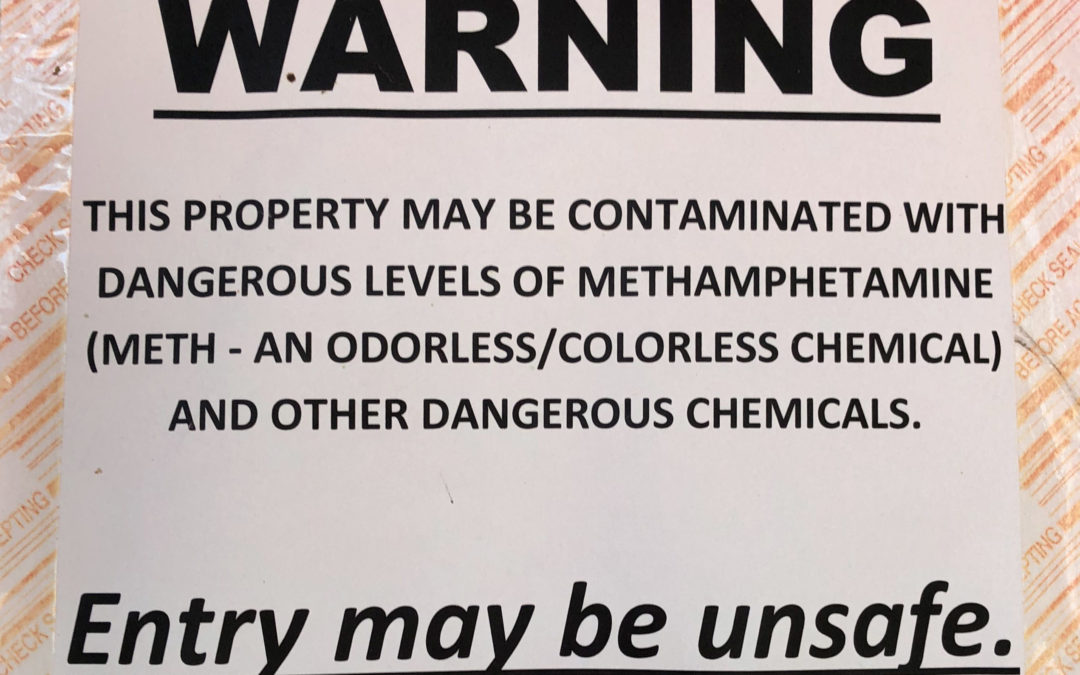With so many variables, it doesn’t make sense to try and summarize the risk in a sweeping generalization. As such, we’re going to approach this topic by presenting a two-tier discussion. First, we’ll look at the facts. Then, we’ll end with a real-life example of just how quickly and intensely meth can impact your health.
However, before we go further we’d like to clarify one point. In Utah, methamphetamine contamination means that your house tests above state limits. (That’s 1.0µg/100cm²). If your property tests above this number, the state of Utah considers it unsafe to inhabit. Period. That means you must decontaminate (or demolish the property). Of course, some people don’t experience symptoms at this level of meth, which leads some to wonder: is the meth in my home actually dangerous, or is all this concern about meth exaggerated? Well, we hope to help you find your answers. So keep reading to find out what the meth in your home could mean for you.
Meth Facts
- Raw meth is dangerous. In the short-term, it can raise body temperature, blood pressure, and heart rate. It is also known to cause seizures, lethal cardiac events, brain hemorrhages, lung collapse, skin legions, and more. In the long-term, you’re looking at insomnia, damage to internal organs, neurotoxicity, rotting teeth, increased risk of stroke and heart attack, brain damage, and worse.
- This substance does not simply disappear. Instead, it takes up residence in your home. In fact, simply smoking meth once is enough to contaminate a home. This is the opinion of the EPA as well.
- You can absorb meth through contact with residue and contaminated surfaces.
- Meth can re-enter the environment through off-gassing. Off-gassing is when certain materials (such as wood) release a chemical back into the air over time.
- When living in a home where meth is present, children can test positive for the substance even without direct contact.
- Meth has a long half-life. It can linger for years.
- Utah’s state limit was set with the intention to ensure absolute safety for anyone who might enter a property. Legislators and health department officials consulted reference dosing, case studies, and other factors to identify the decontamination threshold. That being said, some owners do choose to decontaminate to nondetectable standards (rather than state standards) when justified. Call us to learn more – 801-888-6698.
- Researchers consider infants, children, those with compromised immune systems, and the elderly at higher risk for complications.
- Cooking meth introduces many other toxic chemicals into the environment. That is part of the rationale for requiring decontamination. The argument is that if we find meth, there’s a good chance of other hazardous substances too. Luckily, decontaminating will reduce or eliminate many of these toxins as well.
- Scientists do not know much about the long-term effects of residual methamphetamine exposure. Until they know more, we must assume that symptoms become more likely the longer you’re in a contaminated environment. There may also be long-lasting damage or other complications due to prolonged exposure.
A Cautionary Tale
As you can see, this isn’t a substance to take lightly. Indeed, even otherwise healthy people may find themselves ill due to residual meth. Sadly, that is a story we hear all too often.
Consider the case of one Utah woman. For the sake of privacy, we will call her Jane. Jane recently moved into an apartment with her young son, excited for a change of scenery. However, within the first night, her symptoms started. These included severe cramps, nausea, and a delirious state of mind. She was so sick that she called the last person she ever expected to ask for help: her ex-husband. Once at the hospital, her symptoms ebbed. And as you might expect, they returned when she re-entered her home.
We performed the test ourselves, confirming that there was meth above state limits. Now, we aren’t doctors. We can’t confirm the source of these symptoms was residual meth. However, as she discussed her situation with her property manager, it came to light than a former employee of the apartment complex had dealt drugs out of that same unit. Thankfully, she found a different place to live, and her health returned to normal.
Still, within twenty-four hours of exposure, Jane was ill. And if she hadn’t left her home, there is no telling how bad things could have been. Symptoms can come on quickly, no matter who you are. So, is the meth in your home dangerous? We’d say, at the very least, residual meth can make you ill. And, perhaps the better question is why would you take the chance?
Is the Meth in Your Home Actually Dangerous?
Decontamination standards are meant to keep people safe. Just because you haven’t developed symptoms now doesn’t mean you won’t. And contamination in your home has the potential to expose you, your community, your family, and anyone who enters your home to that same risk. That is why these laws exist, and it is why we encourage you to take this problem seriously.
This one more reason why we recommend testing before buying or selling a home. And, clearly, it can be a good idea even if you’re moving into a rental. So, if you’re relocating or you’ve noticed symptoms of meth exposure, call a Certified Decontamination Specialist today. If you’re in Utah and would like to discuss your situation, give us a call at 801-888-6698.

